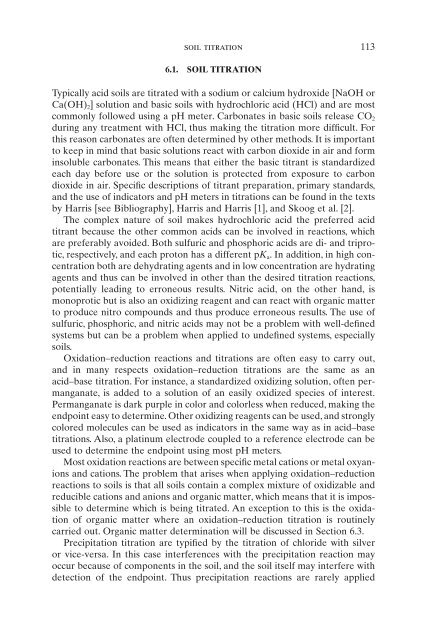Introduction to Soil Chemistry
Introduction to Soil Chemistry
Introduction to Soil Chemistry
You also want an ePaper? Increase the reach of your titles
YUMPU automatically turns print PDFs into web optimized ePapers that Google loves.
soil titration 113<br />
6.1. SOIL TITRATION<br />
Typically acid soils are titrated with a sodium or calcium hydroxide [NaOH or<br />
Ca(OH) 2] solution and basic soils with hydrochloric acid (HCl) and are most<br />
commonly followed using a pH meter. Carbonates in basic soils release CO 2<br />
during any treatment with HCl, thus making the titration more difficult. For<br />
this reason carbonates are often determined by other methods. It is important<br />
<strong>to</strong> keep in mind that basic solutions react with carbon dioxide in air and form<br />
insoluble carbonates. This means that either the basic titrant is standardized<br />
each day before use or the solution is protected from exposure <strong>to</strong> carbon<br />
dioxide in air. Specific descriptions of titrant preparation, primary standards,<br />
and the use of indica<strong>to</strong>rs and pH meters in titrations can be found in the texts<br />
by Harris [see Bibliography], Harris and Harris [1], and Skoog et al. [2].<br />
The complex nature of soil makes hydrochloric acid the preferred acid<br />
titrant because the other common acids can be involved in reactions, which<br />
are preferably avoided. Both sulfuric and phosphoric acids are di- and triprotic,<br />
respectively, and each pro<strong>to</strong>n has a different pK a. In addition, in high concentration<br />
both are dehydrating agents and in low concentration are hydrating<br />
agents and thus can be involved in other than the desired titration reactions,<br />
potentially leading <strong>to</strong> erroneous results. Nitric acid, on the other hand, is<br />
monoprotic but is also an oxidizing reagent and can react with organic matter<br />
<strong>to</strong> produce nitro compounds and thus produce erroneous results. The use of<br />
sulfuric, phosphoric, and nitric acids may not be a problem with well-defined<br />
systems but can be a problem when applied <strong>to</strong> undefined systems, especially<br />
soils.<br />
Oxidation–reduction reactions and titrations are often easy <strong>to</strong> carry out,<br />
and in many respects oxidation–reduction titrations are the same as an<br />
acid–base titration. For instance, a standardized oxidizing solution, often permanganate,<br />
is added <strong>to</strong> a solution of an easily oxidized species of interest.<br />
Permanganate is dark purple in color and colorless when reduced, making the<br />
endpoint easy <strong>to</strong> determine. Other oxidizing reagents can be used, and strongly<br />
colored molecules can be used as indica<strong>to</strong>rs in the same way as in acid–base<br />
titrations. Also, a platinum electrode coupled <strong>to</strong> a reference electrode can be<br />
used <strong>to</strong> determine the endpoint using most pH meters.<br />
Most oxidation reactions are between specific metal cations or metal oxyanions<br />
and cations. The problem that arises when applying oxidation–reduction<br />
reactions <strong>to</strong> soils is that all soils contain a complex mixture of oxidizable and<br />
reducible cations and anions and organic matter, which means that it is impossible<br />
<strong>to</strong> determine which is being titrated. An exception <strong>to</strong> this is the oxidation<br />
of organic matter where an oxidation–reduction titration is routinely<br />
carried out. Organic matter determination will be discussed in Section 6.3.<br />
Precipitation titration are typified by the titration of chloride with silver<br />
or vice-versa. In this case interferences with the precipitation reaction may<br />
occur because of components in the soil, and the soil itself may interfere with<br />
detection of the endpoint. Thus precipitation reactions are rarely applied
















